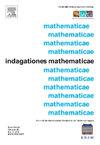Pervasiveness of Lr(E,F) in Lr(E,Fδ)
IF 0.8
4区 数学
Q3 MATHEMATICS
引用次数: 0
Abstract
Let be Archimedean Riesz spaces, and let denote an order completion of . In this note, we provide necessary conditions under which the space of all regular operators is pervasive in . Pervasiveness of in implies that the Riesz completion of can be realized as a Riesz subspace of . It also ensures that the regular part of the space of order continuous operators forms a band of . Furthermore, the positive part of any operator , provided it exists, is given by the Riesz–Kantorovich formula. The results apply in particular to cases where , , or is atomic, and they provide solutions to some problems posed in Abramovich and Wickstead (1991) and Wickstead (2024).
Lr(E,F)在Lr(E,Fδ)中的分布
设E,F是阿基米德Riesz空间,设Fδ表示F的一个序补全。本文给出了所有正则算子Lr(E,F)的空间在Lr(E,Fδ)中泛存的必要条件。Lr(E,F)在Lr(E,Fδ)中的普遍性意味着Lr(E,F)的Riesz补全可以通过Lr(E,Fδ)的Riesz子空间来实现。保证了阶连续算子Loc(E,F)空间的正则部分形成Lr(E,F)带。更进一步,任意算子T∈Lr(E,F)的正部T+,只要存在,则由Riesz-Kantorovich公式给出。这些结果特别适用于E= 0∞、E=c或F是原子的情况,并为Abramovich和Wickstead(1991)和Wickstead(2024)提出的一些问题提供了解决方案。
本文章由计算机程序翻译,如有差异,请以英文原文为准。
求助全文
约1分钟内获得全文
求助全文
来源期刊
CiteScore
1.20
自引率
16.70%
发文量
74
审稿时长
79 days
期刊介绍:
Indagationes Mathematicae is a peer-reviewed international journal for the Mathematical Sciences of the Royal Dutch Mathematical Society. The journal aims at the publication of original mathematical research papers of high quality and of interest to a large segment of the mathematics community. The journal also welcomes the submission of review papers of high quality.

 求助内容:
求助内容: 应助结果提醒方式:
应助结果提醒方式:


